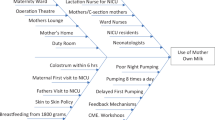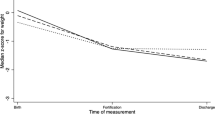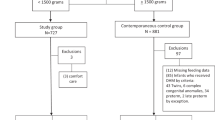Abstract
Objective:
The objective of this study was to compare the currently used human milk (HM) quality indicators that measure whether very low-birthweight (VLBW; <1500 g birthweight) infants ‘ever’ received HM and whether they were still receiving HM at discharge from the neonatal intensive care unit (NICU) to the actual amount and timing of HM received.
Study Design:
This study used data from a large NIH-funded cohort study and calculated whether VLBW infants ever received HM (HM-Ever) and of these infants, the percentage who were still receiving HM at NICU discharge (HM-DC). Then, the HM-DC indicator (exclusive, partial and none) was compared with the amount and timing of HM feedings received by these same infants.
Result:
Of the 291 VLBW infants who met inclusion criteria, 285 received some HM (HM-Ever=98%). At NICU discharge (HM-DC), 24.2, 15.1 and 60.7% were receiving exclusive, partial and no HM, respectively. Of the 60.7% infants with no HM-DC, some had received higher amounts of HM during the NICU hospitalization than infants categorized as exclusive and partial for HM-DC. Of the infants with no HM-DC, 76.8 and 59.7% had received exclusive HM during the days 1–14 and days 1–28 exposure periods, respectively.
Conclusion:
The average daily dose (HM-DD; in ml kg−1 d−1) and cumulative percentage (HM-PCT; as % of cumulative enteral intake) of HM feedings were sufficient to significantly reduce the risk of multiple morbidities, including late-onset sepsis, necrotizing enterocolitis, neurocognitive delay and rehospitalization, in the majority of the VLBW infants who were discharged with no HM-DC. Quality indicators that focus on the amount and timing of HM feedings in the NICU should be added to the HM-Ever and HM-DC measures.
This is a preview of subscription content, access via your institution
Access options
Subscribe to this journal
Receive 12 print issues and online access
$259.00 per year
only $21.58 per issue
Buy this article
- Purchase on Springer Link
- Instant access to full article PDF
Prices may be subject to local taxes which are calculated during checkout

Similar content being viewed by others
References
Meier PP, Engstrom JL, Patel AL, Jegier BJ, Bruns N . Improving the use of human milk during and after the NICU stay. Clin Perinatol 2010; 37: 217–245.
Patel AL, Johnson TJ, Engstrom JL, Fogg LF, Jegier BJ, Bigger HR et al. Impact of early human milk on sepsis and health care costs in very low birthweight infants. J Perinatol 2013; 33: 514–519.
Sisk PM, Lovelady CA, Dillard RG, Gruber KJ, O'Shea TM . Early human milk feeding is associated with a lower risk of necrotizing enterocolitis in very low birth weight infants. J Perinatol 2007; 27: 428–433.
Sisk PM, Lovelady CA, Gruber KJ, Dillard RG, O'Shea TM . Human milk consumption and full enteral feeding among infants who weigh≤1250 grams. Pediatrics 2008; 121: e1528–e1533.
Meinzen-Derr J, Poindexter B, Wrage L, Morrow AL, Stoll B, Donovan EF . Role of human milk in extremely low birth weight infants' risk of necrotizing enterocolitis or death. J Perinatol 2009; 29: 57–62.
Furman L, Taylor G, Minich N, Hack M . The effect of maternal milk on neonatal morbidity of very low-birth-weight infants. Arch Pediatr Adolesc Med 2003; 157: 66–71.
Johnson TJ, Patel AL, Jegier B, Engstrom JL, Meier J . The cost of morbidities in very low birth weight infants. J Pediatr 2013; 162: 243–249.
Johnson TJ In: The cost-effectiveness of human milk feedings as a strategy to reduce the risk of prematurity-specific morbidities in VLBW infants. Proceedings from the 2013 Experimental Biology Meeting; April 20-24 2013 Boston, MA. p. 61.
Vohr BR, Poindexter BB, Dusick AM, McKinley LT, Wright LL, Langer JC et al. Beneficial effects of breast milk in the neonatal intensive care unit on the developmental outcome of extremely low birth weight infants at 18 months of age. Pediatrics 2006; 118: e115–e123.
Vohr BR, Poindexter BB, Dusick AM, McKinley LT, Higgins RD, Langer JC et al. Persistent beneficial effects of breast milk ingested in the neonatal intensive care unit on outcomes of extremely low birth weight infants at 30 months of age. Pediatrics 2007; 120: e953–e959.
Kuzma-O'Reilly B, Duenas ML, Greecher C, Kimberlin L, Mujsce D, Miller D et al. Evaluation, development, and implementation of potentially better practices in neonatal intensive care nutrition. Pediatrics 2003; 111 (4 Pt 2): e461–e470.
Vermont-Oxford Network. Vermont-Oxford Network Database: Manual of Operations. 2013. Report No.: Release April 2013.
Davanzo R, Ronfani L, Brovedani P, Demarini S . Breast feeding very-low-birthweight infants at discharge: A multicentre study using WHO definitions. Paediatr Perinat Epidemiol 2009; 23: 591–596.
Meier PP Health benefits and cost of human milk for very low birthweight infants. 2007, October 1; R01-NR010009-01.
Schanler RJ, Lau C, Hurst NM, Smith EOB . Randomized trial of donor human milk versus preterm formula as substitutes for mothers' own milk in the feeding of extremely premature infants. Pediatrics 2005; 116: 400–406.
Schanler RJ, Shulman RJ, Lau C . Feeding strategies for premature infants: Beneficial outcomes of feeding fortified human milk versus preterm formula. Pediatrics 1999; 103: 1150–1157.
Walker A . Breast milk as the gold standard for protective nutrients. J Pediatr 2010; 156: S3–S7.
Sangild PT . Gut responses to enteral nutrition in preterm infants and animals. Exp Biol Med 2006; 231: 1695–1711.
Sangild PT, Siggers RH, Schmidt M, Elnif J, Bjornvad CR, Thymann T et al. Diet- and colonization-dependent intestinal dysfunction predisposes to necrotizing enterocolitis in preterm pigs. Gastroenterology 2006; 130: 1776–1792.
Mei J, Zhang Y, Wang T, Sangild PT, Xu RJ . Oral ingestion of colostrum alters intestinal transforming growth factor-beta receptor intensity in newborn pigs. Livestock Science 2006; 105: 214–222.
Bjornvad CR, Thymann T, Deutz NE, Burrin DG, Jensen SK, Jensen BB et al. Enteral feeding induces diet-dependent mucosal dysfunction, bacterial proliferation, and necrotizing enterocolitis in preterm pigs on parenteral nutrition. Am J Physiol Gastrointest Liver Physiol 2008; 295: G1092–G1103.
Siggers RH, Siggers J, Thymann T, Boye M, Sangild PT . Nutritional modulation of the gut microbiota and immune system in preterm neonates susceptible to necrotizing enterocolitis. J Nutr Biochem 2011; 22: 511–521.
Thymann T, Burrin DG, Tappenden KA, Bjornvad CR, Jensen SK, Sangild PT . Formulafeeding reduces lactose digestive capacity in neonatal pigs. Br J Nutr 2006; 95: 1075–1081.
Underwood MA, Gilbert WM, Sherman MP . Amniotic fluid: Not just fetal urine anymore. J Perinatol 2005; 25: 341–348.
Wagner CL, Taylor SN, Johnson D . Host factors in amniotic fluid and breast milk that contribute to gut maturation. Clin Rev Allergy Immunol 2008; 34: 191–204.
Penn AH . Digested formula but not digested fresh human milk causes death of intestinal cells in vitro: Implications for necrotizing enterocolitis. Pediatr Res 2012; 72: 560–567.
Taylor SN, Basile LA, Ebeling M, Wagner CL . Intestinal permeability in preterm infants byfeeding type: Mother's milk versus formula. Breastfeed Med 2009; 4: 11–15.
Caicedo RA, Schanler RJ, Li N, Neu J . The developing intestinal ecosystem: Implications for the neonate. Pediatr Res 2005; 58: 625–628.
Verhasselt V . Neonatal tolerance under breastfeeding influence. Curr Opin Immunol 2010; 22: 623–630.
Garofalo R . Cytokines in human milk. J Pediatr 2010; 156 (2 Suppl): S36–S40.
Shulman RJ, Schanler RJ, Lau C, Heitkemper M, Ou C, Smith EO . Early feeding, antenatal glucocorticoids, and human milk decrease intestinal permeability in preterm infants. Pediatr Res 1998; 44: 519–523.
Newburg DS, Walker WA . Protection of the neonate by the innate immune system of developing gut and of human milk. Pediatr Res 2007; 61: 2–8.
Newburg DS . Innate immunity and human milk. J Nutr 2005; 135: 1308–1312.
U.S. Dept. of Health and Human Services. The surgeon general’s call to action to support breastfeeding 2011 Washington, DC, USA, 2011.
American Academy of Pediatrics. Breastfeeding and the use of human milk. Pediatrics 2012; 129: e827–e841.
U.S. Dept. of Health and Human Services. Report of the surgeon general's workshop on breastfeeding & human lactation 1984.
U.S. Dept. of Health and Human Services. In: Followup Report: The surgeon general's workshop on breastfeeding & human lactation 1985.
Galson S . The 25th anniversary of the surgeon general's workshop on breastfeeding and human lactation: The status of breastfeeding today. Public Health Reports 2009; 124: 356–358.
The Joint Commission. Specifications manual for joint commission national quality measures (Version 2013A1). Oakbrook Terrace, IL: The Joint Commission; 2012. Available from https://manual.jointcommission.org/releases/TJC2013A/MIF0170.html.
Feldman-Winter L, Douglass-Bright A, Bartick MC, Matranga J . The new mandate from the joint commission on the perinatal care core measure of exclusive breast milk feeding: Implications for practice and implementation in the united states. J Hum Lact 2013; 29: 291–295.
Acknowledgements
This research was supported by a grant from the National Institutes of Health (NIH Grant # NR010009).
Author information
Authors and Affiliations
Corresponding author
Ethics declarations
Competing interests
The authors declare no conflict of interest.
Rights and permissions
About this article
Cite this article
Bigger, H., Fogg, L., Patel, A. et al. Quality indicators for human milk use in very low-birthweight infants: are we measuring what we should be measuring?. J Perinatol 34, 287–291 (2014). https://doi.org/10.1038/jp.2014.5
Received:
Revised:
Accepted:
Published:
Issue Date:
DOI: https://doi.org/10.1038/jp.2014.5
Keywords
This article is cited by
-
Early pumping frequency and coming to volume for mother’s own milk feeding in hospitalized infants
Journal of Perinatology (2023)
-
Cost Savings of Mother’s Own Milk for Very Low Birth Weight Infants in the Neonatal Intensive Care Unit
PharmacoEconomics - Open (2022)
-
Using a WeChat mini-program-based lactation consultant intervention to increase the consumption of mother’s own milk by preterm infants in the neonatal intensive care unit: a study protocol for a cluster randomized controlled trial
Trials (2021)
-
Quality improvement initiative to improve mother’s own milk usage till hospital discharge in very low birth weight infants from a tertiary care NICU
Journal of Perinatology (2020)
-
NICU human milk dose and health care use after NICU discharge in very low birth weight infants
Journal of Perinatology (2019)



